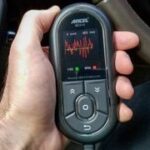The OBD2 (On-Board Diagnostics) system in your 1996 Toyota 4Runner is a valuable tool for diagnosing engine problems. When your 4Runner throws a lean bank code, often indicated by a P0171 (Bank 1 Lean) or P0174 (Bank 2 Lean) code using an ELM327 scanner, it signifies that the air-fuel mixture in one or both engine banks has too much air and not enough fuel. This article will guide you through understanding engine banks and common causes of lean codes in a ’96 4Runner, along with troubleshooting steps using your OBD2 ELM327 scanner.
Understanding Engine Banks and Lean Codes in a 96 4Runner
A 4-cylinder engine has a single bank, while a V6 engine, like the one found in some 1996 4Runners, has two banks with three cylinders each. Bank 1 always includes cylinder #1. A lean code indicates an imbalance in the air-fuel ratio, specifically too much air. This can lead to poor performance, reduced fuel efficiency, and potential engine damage. Toyota issued a Technical Service Bulletin (T-SB-0398-09) addressing the identification of engine banks for correct sensor replacement on various Toyota engines. This bulletin clarifies that Bank 1 (B1) includes cylinder #1 and Bank 2 (B2) is the opposite bank. It also specifies that Sensor 1 (S1) is located before the catalytic converter and Sensor 2 (S2) is positioned after. An ELM327 scanner will pinpoint which bank is experiencing the lean condition.
Common Causes of Lean Codes
Several factors can contribute to a lean code in your 1996 4Runner:
-
Vacuum Leaks: A common culprit, allowing unmetered air into the engine. This can stem from cracked or disconnected hoses, faulty intake manifold gaskets, or issues with the PCV valve.
-
Mass Air Flow (MAF) Sensor Issues: A dirty or malfunctioning MAF sensor can provide incorrect air readings to the engine control unit (ECU), leading to an improper air-fuel mixture.
-
Throttle Position Sensor (TPS) Problems: A faulty TPS can disrupt the air-fuel ratio by providing inaccurate throttle position data to the ECU.
-
Fuel Pressure Regulator (FPR) Malfunction: A failing FPR can cause insufficient fuel pressure, resulting in a lean condition.
-
Faulty Fuel Pump: A weak fuel pump may not deliver enough fuel to meet the engine’s demands, particularly under load. This can trigger a lean code, often accompanied by hesitation during acceleration.
-
Clogged or Faulty Fuel Injectors: A clogged injector restricts fuel flow to a specific cylinder, causing a lean condition in that bank. While often accompanied by a misfire code, it’s not always the case.
Troubleshooting Lean Codes with an ELM327
-
Initial Checks: Start by cleaning the MAF sensor and TPS. Test these components after cleaning to ensure proper function.
-
Vacuum Leak Detection: Use flammable brake cleaner to check for vacuum leaks. With the engine running, spray short bursts around the intake manifold, vacuum lines, PCV valve, and throttle body. A noticeable change in engine idle speed indicates a leak in that area.
-
Fuel System Inspection: If no vacuum leaks are found, check the fuel pressure regulator and overall fuel pressure. A weak fuel pump should be replaced.
-
Fuel Injector Testing: On a V6, swap injectors between banks. Clear the code with your ELM327 and drive until the code reappears. If the lean code switches banks, a faulty injector is likely the cause. Cleaning or replacing the injector may resolve the issue.
Conclusion
Diagnosing and resolving lean codes in your 1996 4Runner requires a systematic approach. By utilizing an OBD2 ELM327 scanner and following these troubleshooting steps, you can pinpoint the root cause and restore your 4Runner’s performance and fuel efficiency. Remember to consult your vehicle’s repair manual for specific procedures and safety precautions.


